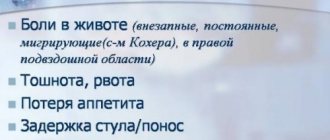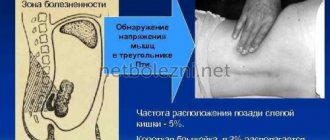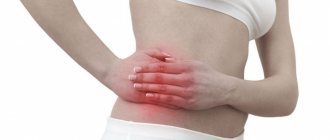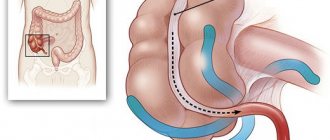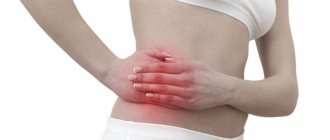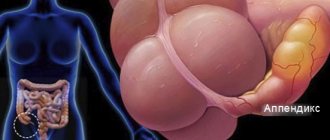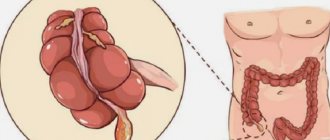There are contraindications. Specialist consultation is required.
Causes and symptoms Diagnosis and preparation Appendectomy Laparoscopic removal Recovery
The appendix is a vermiform appendix of the cecum, located between the small and large intestines. Its length in humans is 5-15 cm, diameter -1 cm. It is believed that its function is to protect the small intestine from bacteria living in the cecum. In the event of an inflammatory process (appendicitis), immediate removal of the entire appendix is indicated.
The essence of the operation on the appendix is to excise the inflamed appendix of the cecum and remove it through a small incision on the right side.
What is an appendectomy?
Appendectomy is a surgical operation to remove the appendix.
The appendix is a vermiform appendage that is an appendage of the cecum. It is believed that the appendix stimulates the immune system and improves the body's defense resources. The appendix is a cylindrical organ, hollow inside and without a through passage. The average length of the appendix is 8–10 cm. Appendicitis is a disease associated with inflammation of the appendix. It can occur in acute or chronic form. In chronic appendicitis, appendectomy is performed routinely. An acute form of inflammation of the appendix requires timely surgical intervention.
On which side is appendicitis located?
Even at a conscious age, not all people know where appendicitis is located . Some think it is on the left side of the abdomen, others say it is on the right side.
A healthy appendix is small in size and looks like a tube or appendage 10 mm long, which is located in the lower right part of the abdomen. During the inflammatory process, the appendix increases in size and puts pressure on the intestinal walls, which causes pain.
on which side is appendicitis located?
Causes of appendicitis
Inflammation of the appendix is caused by opportunistic microorganisms. When examining the affected tissue of the inflamed appendix, Escherichia coli, enterococcus, streptococcus, Staphylococcus aureus and anaerobic microorganisms are most often found. Pathogenic microorganisms penetrate the wall of the appendix from its lumen.
Doctors identify factors that provoke inflammation of the appendix:
- inflammatory process in the intestines;
- deformation of the appendix, in which there is a violation of blood circulation in the walls of the organ, which leads to necrosis of the appendix tissue;
- blockage of the appendix - fecal stones, neoplasms, foreign bodies and accumulation of parasites can close the lumen of the appendix. At the site of the blockage, microbes begin to actively multiply, causing inflammation.
Symptoms of atypical appendicitis
The main reason for the absence of the classic course of appendicitis is the variations in the position of the appendix relative to nearby organs and the peritoneum. Pelvic and retrocecal forms are accompanied by the most severe course; gangrenous and perforative types of inflammation occur more often. This depends on erroneous and delayed diagnosis. Let us dwell on the recognition of these forms.
Pelvic position of the inflamed appendix
Instead of the most clear symptoms, the patient has dysuric disorders:
- frequent urination;
- cutting and pain above the pubis.
Signs of intestinal damage:
- loose, frequent stools;
- sometimes a false urge to defecate (tenesmus).
These signs are caused by involvement of the bladder and rectum in the inflammatory process.
The tension in the abdominal muscles is weak. In diagnosis, it is important to conduct a rectal examination to identify infiltration around the appendix. Women should consult a gynecologist.
Retrocecal appendicitis
It is characterized by severe symptoms of general intoxication (fever, vomiting, nausea, headache) with minor local signs. It is recommended to palpate the patient in a position on the left side with both hands, pressing from the lower back and right half of the abdomen.
If the doctor is unsure of the absence of appendicitis, an operation should be performed and the diagnostic issue should be resolved during the intervention. Delaying observation is dangerous for the patient's life.
Symptoms of appendicitis inflammation
Chronic appendicitis is a sluggish inflammation of the appendix of the cecum, as a result of which the walls of the organ are replaced by scar tissue and infiltrated by immunocompetent cells. Doctors distinguish three forms of chronic appendicitis:
- Recurrent form - characterized by alternating periods of exacerbation and remission with minor clinical manifestations (moderate pain in the right iliac region).
- Residual form (residual) - develops when, after an acute attack, inflammatory phenomena in the appendix are only partially relieved.
- Primary chronic form - develops without a primary acute attack, development occurs gradually.
As a rule, chronic inflammation of the appendix is accompanied by a dull aching, stabbing or pressing pain in the right iliac region. Pain, as a rule, intensifies with physical activity and poor diet.
Acute inflammation of the appendix begins with swelling of the organ, then it begins to fill with pus.
Appendicitis - a “chameleon” disease
Acute appendicitis is one of the most common abdominal diseases requiring surgical treatment. At the Morozov Children's Hospital, about 600 appendectomies are performed annually - operations to remove the appendix of the cecum. In almost 10% of cases, the disease has a complicated form (peritonitis, periappendiceal infiltrate and abscess).
As a rule, complications arise due to untimely seeking of specialized medical care, because the symptoms of appendicitis can be disguised as a number of other diseases. The head of the surgical department of the Morozov Children's Hospital, coloproctologist, pediatric surgeon of the highest category, candidate of medical sciences, holder of the status “Moscow Doctor” Mikhail Kozlov told how to recognize the disease in time, which treatment methods are most effective.
How often are children diagnosed with acute appendicitis?
Acute appendicitis is an acute inflammation of the appendix of the cecum. The overall incidence ranges from 3 to 6 per 1,000 children. Girls and boys get sick equally often. Can occur at any age, including newborns. Up to 3 years, the incidence does not exceed 8%. The peak incidence occurs in children aged 9–12 years. Moreover, in children, appendicitis develops faster, and destructive changes in the appendix, leading to appendiceal peritonitis, occur much more often than in adults.
Why does the disease occur?
Acute appendicitis is an enterogenous autoinfection. The disease is caused by its own opportunistic microbial flora - a group of microorganisms that are constantly present on the mucous membranes and in the human intestines, peacefully coexisting with the body. Under unfavorable conditions, for example, with weakened immunity or a viral infection, the number of opportunistic microbes reaches a concentration that causes the development of the disease. Inflammation occurs in the appendix. The lumen of the appendix swells and the mucous secretion, having no exit from the appendix, accumulates and becomes infected.
How does the disease manifest in children? What should parents pay attention to?
The main symptoms of the disease are pain in the abdomen and fever. But the clinical picture of appendicitis can be varied. Depending on the location of the appendix, the severity and nature of pain can vary significantly. If the appendix has a special localization, which happens in approximately half of the cases, the clinical manifestations of the disease are atypical. For example, if the appendix is located deep in the pelvis, then there may be no pain when palpating the abdomen. In this case, it is necessary to pay attention to the nature of the stool, the urge to defecate, and the frequency of urination. This location of the appendix in girls during puberty can simulate inflammation of the appendages.
If the process is located at the top under the liver, then when palpating the abdomen through the upper abdominal wall, the pain syndrome will also not be expressed. If appendicitis imitates renal colic, the patient will complain of lower back pain. In the case where the appendix is located medially in the center of the abdomen, the child will feel severe pain in the navel. If the appendage is located on the rectum, the patient may complain of frequent bowel movements.
Difficulties in diagnosing the disease at an early stage are also due to the fact that symptoms characteristic of acute appendicitis can be observed in many other diseases. For example, ARVI often occurs with abdominal syndrome. Only a surgeon can reliably determine the disease, taking into account the examination of the patient and research. In some cases, dynamic observation is recommended.
What types of diagnostics are the most informative?
Most often, an examination by a surgeon and a general blood test are sufficient to confirm the diagnosis. If the clinical picture is unclear, an ultrasound of the abdominal organs is recommended. Expert class ultrasound machines, which the Morozov Hospital is equipped with, allow you to accurately visualize tissue and differentiate the appendix. Also, auxiliary types of diagnostics are of great importance when diagnosing newborns and children under one year old. We operate on 10-15 children with acute appendicitis per year.
How is appendicitis treated?
Treatment of appendicitis involves removal of the appendix of the cecum. In the last few years, as a rule, only laparoscopic operations have been performed. We have accumulated vast experience in performing minimally invasive interventions for this pathology - back in the Izmailovskaya Hospital we were one of the first to begin performing low-traumatic appendectomies. With this operation, access is made through small punctures in the anterior abdominal cavity. For typically located uncomplicated appendicitis, the operation lasts about 15-20 minutes. The child recovers quickly and is discharged from the hospital within 2-3 days.
What are the dangers of delaying seeking medical help?
After a day or two from the onset of the disease, inflammation from the appendix of the cecum begins to spread to the surrounding tissues: the ureter, appendages, bladder, rectum. Appendicitis is complicated by peritonitis. If the child is admitted 10 days or more from the moment of illness, the appendix fragments and we detect diffuse fecal peritonitis. This is a very serious condition in which, in extremely rare cases, the child may need to undergo abdominal surgery, with the establishment of an ostomy for some time. Repeated sanitation is carried out only after complete cleansing and elimination of the inflammatory process.
Is it possible to remove the appendix for prophylactic purposes?
Surgical intervention in the abdominal cavity without medical indications is unacceptable.
Symptoms of acute appendicitis:
- severe abdominal pain, which may intensify with palpation;
- constipation or diarrhea;
- nausea, vomiting;
- loss of appetite;
- flatulence (bloating);
- temperature increase.
If such symptoms occur, it is important to seek medical help promptly. If the appendix is not removed in a timely manner, perforation (rupture) of the organ may occur, causing pus to enter the abdominal cavity and cause peritonitis, a complication that can be fatal.
If you are concerned about one or more of the above symptoms, contact your surgeon immediately for advice. You can make an appointment at a convenient time with a surgeon at Euromed Clinic by phone + or online.
Diagnostics
The diagnosis of acute appendicitis is made based on the symptoms described above: pain in the right iliac region (can be in the upper abdomen and umbilical region), nausea, single vomiting, increased body temperature (the temperature difference of more than one degree in the rectum and axillary region is important here), pain on palpation in the right iliac region, blood leukocytosis (increased number of leukocytes), increased ESR, the presence of symptoms of irritation of the peritoneum along with the location of the appendix.
If there are difficulties in making a diagnosis, laparoscopy is used. This is an examination of the abdominal organs with a special optical device inserted into the abdomen through a puncture.
Often, making a diagnosis of acute appendicitis presents certain difficulties, which is associated with the atypical location of the appendix and the degree of inflammation in it. Acute appendicitis must be distinguished from other diseases of the abdomen, chest organs and retroperitoneal space. If you suspect appendicitis in a patient, you need to remember about diseases such as perforated gastric and duodenal ulcers, acute cholecystitis, acute pancreatitis, inflammation of the uterine appendages and impaired ectopic pregnancy, renal colic, dysentery and gastroenteritis, pleurisy and myocardial infarction. Just as when you suspect these diseases, you should always keep acute appendicitis in mind, because it can give a clinical picture of any of the diseases listed above.
Acute appendicitis in children is characterized by a rapid course and resembles gastroenteritis and dysentery, which complicates diagnosis and increases the number of perforated forms of appendicitis.
In elderly people, on the contrary, acute appendicitis occurs in an erased form with a weak clinical picture, so such patients are admitted to surgical hospitals at a later date.
Indications for appendectomy
Surgery to remove the appendix is used for chronic or acute forms of appendicitis. In addition, appendectomy is performed if there is an appendiceal infiltrate, as well as if neoplasms are detected in the appendix.
Emergency appendectomy is usually performed no later than one hour after diagnosis. In case of chronic appendicitis or appendicular infiltrate, surgery to remove appendicitis is performed as planned.
Complications
Complications of acute appendicitis include: infiltrates and ulcers of the abdominal cavity, diffuse peritonitis, pylephlebitis.
Appendiceal infiltrate is a conglomerate consisting of inflamed intestinal loops and the greater omentum and forming around the appendix. Appendiceal infiltrate can be considered as a protective reaction of the body, in which it forms walls from its own tissues around the appendix. These walls prevent further spread of the inflammatory process in the abdominal cavity.
If the body's forces are not strong enough, the appendiceal infiltrate does not resolve, but rather it suppurates, resulting in the formation of a periappendiceal abscess. In this case, an abscess can form not only near the appendix, but anywhere in the abdominal cavity - between intestinal loops, under the liver, in the pelvic cavity and other places. When an abscess forms in the abdominal cavity, the patient’s condition sharply worsens, the temperature rises, and high leukocytosis is detected in the blood.
A serious complication of acute appendicitis is diffuse peritonitis. This occurs when the pus is not limited to walls of its own tissue, as in the case of an abscess, but is distributed throughout the peritoneum.
Pylephlebitis is purulent inflammation of the portal vein. Through the portal vein, blood from the intestines enters the liver for cleansing and disinfection. As a result of purulent inflammation of the portal vein, abscesses develop in the liver, and bacteria begin to multiply in the blood (sepsis). The mortality rate for this complication is extremely high.
The main methods for removing appendicitis:
- Open appendectomy - performed through an 8-10 cm incision in the right iliac region. Through the resulting incision, the surgeon separates the appendix from the surrounding tissues and then removes the organ. Removal of appendicitis using this method is indicated when the infectious process has spread into the abdominal cavity or when the appendix is located incorrectly.
- Laparoscopic appendectomy is an endoscopic method that allows you to cut out the appendix through three small punctures in the abdominal wall. This type of operation to remove appendicitis is performed routinely for chronic and acute uncomplicated appendicitis. Laparoscopy for appendicitis is a minimally invasive procedure, since the operation causes minimal trauma to the anterior abdominal wall.
Causes and symptoms
Doctors identify a number of reasons that can lead to inflammation of the appendix:
- bends of the appendix, its increased mobility;
- blockage of the appendix with undigested parts of food or constipation;
- infectious or inflammatory process in the intestines;
The development of inflammation occurs gradually: first the appendix swells, then begins to fill with pus. Without removal, after two to three days the appendix ruptures and pus leaks into the abdominal cavity, causing peritonitis. This condition can lead to the death of the patient. The main symptom of appendicitis is pain in the abdomen: first in the upper part, then the pain is localized in the lower right part. Sometimes the patient may experience pain in the right hypochondrium, radiating to the back or anus. Other symptoms of the disease:
- increased pain when pressing on the abdomen;
- abdominal muscle tension;
- nausea and vomiting;
- change in bowel habits (constipation or diarrhea);
- temperature increase.
Senko Vladimir Vladimirovich
Leading surgeon oncologist at SM-Clinic. Doctor of the highest category.
Deputy Chief Physician for Surgery.
Head of the surgical hospital "SM-Clinic".
“During laparoscopic surgery, instruments are inserted into the abdominal cavity through pinhole punctures on the anterior abdominal wall. Usually, 3 punctures up to 1 cm long are enough. A video camera is inserted into one of them so that the surgeon can see the progress of the operation on the monitor. Sometimes, at the beginning of the operation, factors are discovered that prevent it from being performed laparoscopically. Then an open appendectomy is performed.”
Contraindications for laparoscopic appendectomy:
- late stages of pregnancy;
- severe blood clotting disorders;/li>
- undergone operations on the abdominal organs;/li>
- severe cardiovascular and respiratory failure;/li>
- abnormal location of the appendix;/li>
- old age;/li>
- pronounced adhesive process;/li>
- widespread peritonitis requiring sanitation and drainage of the abdominal cavity;/li>
- dense appendicular infiltrate;/li>
- gangrenous appendicitis./li>
Laparoscopic appendectomy
Laparoscopy is performed for uncomplicated inflammation of the appendix. Minimally invasive surgery for appendicitis is performed under intubation (endotracheal) anesthesia.
The evening before the appendectomy and on the day of the operation, you should not eat, and two hours before the intervention you should not drink. Before performing a laparoscopic appendectomy, the surgeon will refer you to a therapist for an initial consultation and order laboratory tests.
A blood test for appendicitis is necessary to determine the total number of leukocytes, an increase in which indicates suppuration of the appendix. Ultrasound of the abdominal organs with appendicitis shows the position of the appendix relative to other organs, as well as enlargement or thickening of the walls of the appendix.
Other tests before laparoscopic appendectomy include:
- IgM ELISA test for Covid-19;
- HIV antibody test;
- analysis for blood group and Rh factor;
- analysis for total antibodies to syphilis;
- tests for hepatitis B and C viruses;
- clinical urine analysis;
- coagulogram;
- electrocardiogram.
During a laparoscopic appendectomy, the surgeon makes a puncture in the navel, inserts gas, a camera and instruments, and examines the abdominal cavity. The doctor removes the appendix through the umbilical port and loads it into a container, then stitches it up. After surgery, the appendix is sent for analysis for cancer cells.
Preparing for an appendectomy:
In acute appendicitis, preparation for appendectomy is carried out promptly; as a rule, the condition of the patient's cardiac and respiratory systems is assessed.
For a planned operation , the results of blood tests, urine tests, fluorography, and an electrocardiogram are required. Women need to be examined by a gynecologist to rule out inflammatory processes that can lead to complications.
You should not take food or water for at least six hours before surgery. In case of laparoscopic surgery, it is necessary to first perform an ultrasound of the abdominal cavity.
Recommendations
If you experience abdominal pain, seek medical attention immediately. If pain occurs at night or on weekends, call an ambulance. Do not take any painkillers other than no-shpa, as this can erase the clinical picture of an acute disease, which leads to late diagnosis and complications.
Remember, the sooner you contact a specialist, the lower the risk of complications. If treated in a timely manner, surgical treatment is limited to appendectomy only (removal of the appendix).
If you have a choice, then contact a medical institution that can perform a laparoscopic appendectomy. But even if the clinic does not have equipment for laparoscopic operations, an experienced surgeon can perform an appendectomy from a small incision (3–4 cm) followed by a cosmetic intradermal suture.
It happens that in the presence of a clinical picture of acute appendicitis, entering the abdomen, the surgeon sees an unchanged appendix. In such cases, he must check the entire abdominal cavity, identify the cause of the disease and eliminate it. That is why an experienced, highly qualified surgeon is needed.
How to remove appendicitis during laparoscopy
Patients are often interested in what anesthesia is used to remove appendicitis. Surgery is performed under general anesthesia. At the beginning of the operation, the patient is given anesthesia. After antiseptic treatment of the skin in the area of the operation, in the anterior abdominal wall (in the pubic area and right hypochondrium), the surgeon makes three small incisions. The laparoscope is inserted through the first incision, which is located just above the navel. Through other holes, special instruments are inserted to hold the appendix. Next, the surgeon removes the inflamed appendage and removes it from the abdominal cavity.
This is followed by suturing. Typically, absorbable suture material is used and does not require subsequent removal.
Diagnosis of appendicitis
The first step in examining a patient is an examination and history taking. The doctor asks you to tell us when the symptoms began and how long the discomfort lasts. This is important to understand in order to distinguish the disease from something else.
It is important to consider other factors that could cause the development of appendicitis:
- Surgical operations in the abdominal area in the recent past.
- Taking medications or supplements.
- Bad habits, abuse of alcohol, drugs, etc.
Feeling the abdomen will help determine the location and intensity of pain, its characteristics. A pelvic and rectal examination may be necessary. The final diagnosis is made only after laboratory tests. Blood and urine tests can help detect signs of inflammation or other health problems.
Visual examination methods may also be required - ultrasound of the abdominal organs, CT or MRI. They will allow:
- determine the condition of the appendix and assess its integrity
- detect signs of inflammation
- evaluate blockage inside the appendix
- identify an abscess or other complications
Recovery after laparoscopic appendectomy
After appendectomy using the laparoscopic method, restoration of work capacity and return to a normal lifestyle occurs faster. As a rule, after 1–2 days the patient is discharged from the hospital. After the operation, the surgeon will prescribe antibacterial therapy and give recommendations on diet and physical therapy to quickly restore the body.
At Euromed Clinic, surgeons perform both open and laparoscopic appendectomies.
What measures are recommended after appendicitis?
After appendicitis, the patient must adhere to relatively simple and feasible restrictions for 1-2 months. They are quite simple to implement, especially considering that ignoring them is fraught with quite unpleasant and undesirable consequences.
Diet after appendicitis
After appendicitis, independent consumption of food is allowed from the third day after surgery, but food during this period should be ground and mushy. Milk and milk jelly, liquid porridge (preferably with water), chicken and vegetable broth, and vegetable purees are allowed. Dietary nutrition begins on the sixth day. Some dietary features are prescribed to the patient in the first 2-3 months after surgery. Diet affects the composition of the intestinal microflora and the activity of its functions. The following principles must be followed:
- small and frequent meals; simultaneous consumption of large portions of food is contraindicated;
- food should not be hot or cold, but only slightly warmed up;
- nutritious nutrition that provides the body with the entire spectrum of nutrients, vitamins and minerals, since stimulation and strengthening of the immune system is required during the recovery period;
- exclusion of products that promote fermentation and gas formation in the digestive tract; The diet should not contain legumes, heavy animal fats, any varieties of cabbage, smoked meats, marinades and pickles, and the consumption of alcoholic and carbonated drinks is not recommended.
While the diet should be complete, with sufficient protein content and the exclusion of only heavy fats, after appendicitis the patient is strongly advised to monitor his weight. Since physical activity is significantly minimized in the postoperative period, it is easy to gain excess weight, which is extremely undesirable.
To restore normal microflora, the body benefits from dairy and fermented milk products and plenty of drinking water. Meat and fish should not be consumed in the first weeks after appendicitis, but broths and pureed minced meat/fish are acceptable. If consuming fiber serves as an excellent prevention of appendicitis, then in the first week after surgery it is, on the contrary, undesirable. It is better to give up bread and baked goods; an excellent alternative can be bread, which contains a minimum of fiber and carbohydrates. Vegetables (carrots, beets) and bananas are perceived favorably by the body; it is better to avoid citrus fruits. At the same time, for immunization the body needs vitamin C, which can be obtained from other foods or consumed in tablet form, as well as other vitamins and vitamin-mineral complexes.
The end of the diet after appendicitis should not be abrupt. It is recommended to gradually expand the diet. Under no circumstances should you suddenly lash out at foods that were previously excluded from your diet. In general, the postoperative diet is not strict, and therefore it will be useful to follow the rules that have already been familiar for several months in the future. This will only benefit the body.
Physical activity after appendicitis
The patient is allowed minimal physical mobility the next day after surgery, but it is recommended to get out of bed only on the third day.
Over the next 6 weeks, muscle fusion occurs, against which the risk of adhesions and even hernias remains. Heavy lifting and active physical activity are strictly prohibited. At the same time, it is noted that daily walking at a leisurely pace of 2-3 kilometers in the afternoon helps prevent adhesions. Therapeutic gymnastics is prescribed. It is noteworthy that the best restoration of muscle tissue occurs in those individuals who, before developing appendicitis, led an active lifestyle and kept their body in good shape.
As with diet, the increase in physical activity after appendicitis should not be sudden. After a few months, you can return to moderate exercise, gradually supplementing therapeutic exercises with general exercises.
Consequences of appendix removal for the body
As already noted, the appendix is considered an atavism. For modern humans, this is a rudimentary organ, the absence of which does not significantly affect the functioning of the body and the digestive system in particular. At the same time, the appendix produces some secretions and hormones, and lymphoid formations are located here.
Removal of the appendix means a temporary weakening of the immune system both due to the elimination of lymphoid cells and due to external intervention, the risk of infection entering the body. This risk can be overcome through artificial stimulation of the immune system, good nutrition, minimizing stress and active physical activity, and creating generally favorable conditions for rehabilitation.
Advantages of performing an appendectomy at Euromed Clinic:
- Euromed Clinic is a full-service clinic. Before the operation, if necessary, we will arrange for you consultations with a therapist, cardiologist and any other specialist;
- Our own laboratory allows you to take the necessary tests at once and quickly get results;
- all surgeons at Euromed Clinic are experienced and qualified specialists;
- the operating room is equipped with modern medical equipment;
- use of the latest generation of anesthesia;
- own hospital with modern comfortable rooms;
- experienced surgeons at the clinic use the most modern dressing and suture materials and disposable instruments;
- All reusable metal instruments undergo a three-stage sterilization system and are then placed in vacuum packaging to ensure the sterility of the instrument.
You can make an appointment at a convenient time with a surgeon at Euromed Clinic by calling + 7 812 327 03 01 or online.
Blind but dangerous
The appendix is a short and thin blind vermiform appendix 7-10 cm long, located at the end of the cecum (the initial part of the large intestine). Like any part of the intestine, the appendix produces intestinal juice, but so little that it does not play a special role in digestion. Therefore, for a long time it was considered a “mistake of nature” and was removed by the patient at the first opportunity. But recently, scientists discovered lymphoid cells in the caecum, the same as in human tonsils. And since these cells have the properties to protect the body from infections, the assumption was born that the appendix is part of the immune system.
However, the number of protective cells in it, as it turned out, is very insignificant and cannot have a strong effect on the immune system. So most experts are still confident that there is no benefit from the appendix, but the harm in case of its inflammation can be significant: acute appendicitis not diagnosed in time can cost not only health, but also life.
Signs of appendicitis in children
Symptoms of appendicitis are quite characteristic
If an adult can explain where, what and how it hurts, then with a child everything is much more complicated. And the younger the child, the more difficult it is to conduct an anamnesis. He cannot explain either the nature of the pain or its location. The child just hurts everything.
But, having heard that they are leaving him in the hospital and that something will be cut out, the baby may unexpectedly “get well.” Don't flatter yourself. The child does not understand that his deception may cost him his life. He wants to return to his usual life, and be closer to his mother, to his family, to everything that promises him warmth and security.
He may begin to be capricious and throw a tantrum demanding to be taken home. Explain to him that the subsided pain is the death of the nerve endings that should feel pain, and that if he does not listen to the doctor, he may die. Try to be with your child at these moments.
